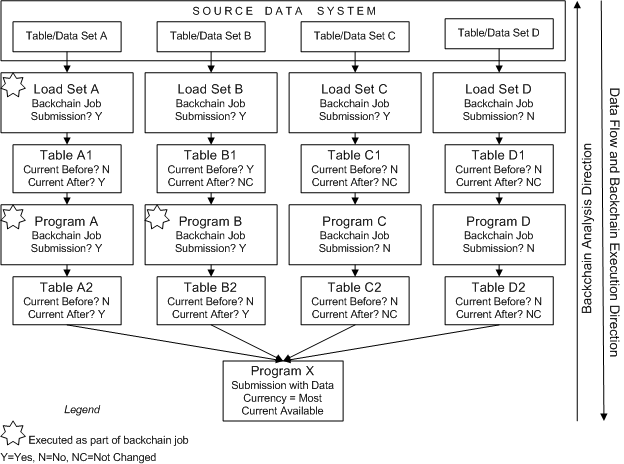How Backchaining Works
When at least one of the Programs or Load Sets that writes data to a Table instance that a Program instance reads from has a backchain Execution Setup defined and submitted, Oracle LSH displays "Most Current Available" as an allowed value for the Data Currency system parameter in the Execution Setup for the Program instance. When a user submits a job with the Data Currency parameter set to Most Current Available, the system invokes a backchain process that does the following:
-
The backchain process checks each Program or Load Set instance that writes to the job's source Table instances, looking for a job submission with the Submission Type system parameter set to Backchain. This is a backchain job submission. (To create a backchain job submission, create an Execution Setup with Submission Type set to Backchain and submit it for execution.)
-
For each Program instance with a backchain job submission, the backchain process checks each Program or Load Set instance that writes to its source Table instances to see if those Programs or Load Set instances also have a backchain job submission.
-
The backchain job continues to look farther and farther upstream each branch of the data flow until it reaches either the source data system or a Program or Load Set instance that does not have a backchain job submission.
-
On each branch, when the backchain job has gone as far upstream as it can, it compares the data currency of the source and target data of the last Program or Load Set that has a backchain job submission.
-
If the source data is more current than the target data, the backchain process executes the Program or Load Set instance to refresh the target data. The backchain job then executes the next Program to refresh its target data, and so on. Each job submitted by the backchain process uses the blinding and priority system parameter values set in the job submitted by the user with the data currency set to Most Current Data Available.
-
If the target data is already as current as the source data, the backchain job does not execute the Program or Load Set instance, but instead checks the source and target data currency of the next Program downstream, and so on. When it finds a Program whose target data is less current than its source data, the backchain job executes that Program instance and each subsequent Program instance.
-
When all branches with backchaining enabled have the most current possible data, the backchain job triggers the execution of the original job submitted (with Data Currency set to Most Current Available). See Figure 12-1.
ADDITIONAL INFO: BH: When a backchain process triggers a backchain ES, does it create a new job for it? and display that job in the UI too?
JREES: Yes, a Master Job for that execution setup is started and shows up in Job UI as a normal job. In fact, CDR also creates a 'cloned' version of the backchain submission (see below) for each job that is started, as well. This is because the submission must pick up certain of the system parameters (such as blinding and priority) from the job that initiated the backchain.
BH: Does the backchain logic look for the existence of an ES with a submission type of Backchain, or for the submitted job of submission type Backchain?
JREES: It looks for a Submission with submission type of Backchain. When you submit a job, CDR creates a submission record and a Job record for the first execution of the job (repeating jobs create a new job record for each time they repeat, but only have the one submission).
In the example shown in Figure 12-1, the user submits Program X with the Data Currency system parameter set to Most Current Available. This submission starts a backchain process that checks all the Programs that populate the Table instances that Program X reads from for a backchain job submission. In this example, the backchain process finds that Programs A and B have backchain job submissions, but Programs C and D do not. The backchain process then checks the Load Sets that populate the source Table instances of Programs A and B for a backchain job submission. Load Sets A and B both have backchain job submissions.
The backchain process then checks the data currency of the Load Sets' source and target data. Load Set A's target data is less current than its source, but Load Set B's target data is current. The backchain process checks the data currency of Table B1 compared to Table B2, and finds that B2 is less current.
The backchain process executes Load Set A, and Table A1 becomes current. The backchain process executes Program A, and Table A2 becomes current. The backchain process executes Program B, and Table B2 becomes current. The backchain process then executes Program X, which then has the most current data available. However, because Programs C and D did not have backchain jobs submitted, Program X does not have the most current data from the source system for those streams. This is true even for stream C, where Load Set C has a backchain job submission but Program C does not.
Note that even if Table A2 is current in relation to its source Table before the backchain process, it becomes noncurrent after the execution of Load Set A updates Table A1. However, Program A then runs and Table A2 becomes current again.
Parent topic: Backchaining
